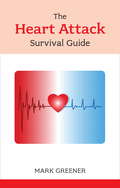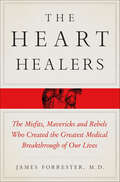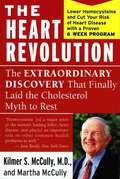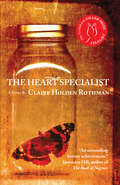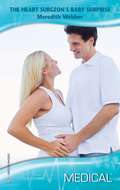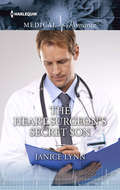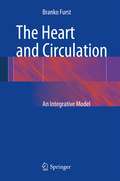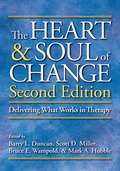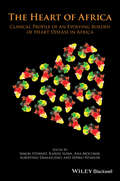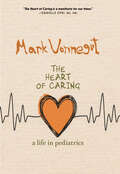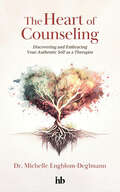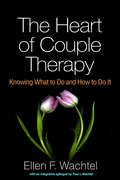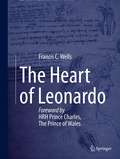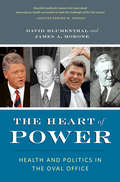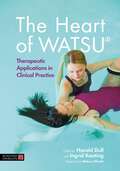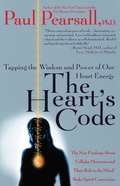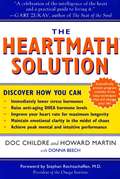- Table View
- List View
The Heart Attack Survival Guide
by Mark GreenerCoronary heart disease, the commonest cause of heart attacks, remains the leading cause of death in the UK, despite rates falling in the last few decades, despite numerous therapeutic advances and despite increased awareness. Rates are especially high in economically deprived communities, some ethnic groups and at certain ages; but everyone's at risk. This book aims to help people at high risk prevent their first or subsequent heart attack as well as helping those who experience a heart attack get back to a normal life as soon as possible. As this book shows, combining drugs and lifestyle changes can help you survive - and prevent - heart attacks. Topics include: The anatomy and physiology of the cardiovascular system; Modifiable and non-modifiable risk factors such as smoking, diet, age, family history and sex; Causes and types of heart attack; Why heart attacks are more common at certain times of day; Prognosis - what makes survival more likely; Symptoms in men, women and the elderly; Diagnosis and treatment; After a heart attack - physical, psychological and lifestyle factors; Preventing heart attacks; Caring for a loved one after a heart attack.
The Heart Attack Survival Guide
by Mark GreenerCoronary heart disease, the commonest cause of heart attacks, remains the leading cause of death in the UK, despite rates falling in the last few decades, despite numerous therapeutic advances and despite increased awareness. Rates are especially high in economically deprived communities, some ethnic groups and at certain ages; but everyone's at risk. This book aims to help people at high risk prevent their first or subsequent heart attack as well as helping those who experience a heart attack get back to a normal life as soon as possible. As this book shows, combining drugs and lifestyle changes can help you survive - and prevent - heart attacks. Topics include: The anatomy and physiology of the cardiovascular system; Modifiable and non-modifiable risk factors such as smoking, diet, age, family history and sex; Causes and types of heart attack; Why heart attacks are more common at certain times of day; Prognosis - what makes survival more likely; Symptoms in men, women and the elderly; Diagnosis and treatment; After a heart attack - physical, psychological and lifestyle factors; Preventing heart attacks; Caring for a loved one after a heart attack.
The Heart Healers: The Misfits, Mavericks, and Rebels Who Created the Greatest Medical Breakthrough of Our Lives
by James ForresterAt one time, heart disease was a death sentence. In The Heart Healers, world renowned cardiac surgeon Dr. James Forrester tells the story of the mavericks and rebels who defied the accumulated medical wisdom of the day to begin conquering heart disease. By the middle of the 20th century, heart disease was killing millions and, as with the Black Death centuries before, physicians stood helpless. Visionaries, though, had begun to make strides earlier. On Sept. 7, 1895, Ludwig Rehn successfully sutured the heart of a living man with a knife wound to the chest for the first time. Once it was deemed possible to perform surgery on the heart, others followed. In 1929, Dr. Werner Forssman inserted a cardiac catheter in his own arm and forced the x-ray technician on duty to take a photo as he successfully threaded it down the vein into his own heart...and lived. On June 6, 1944 - D-Day - another momentous event occurred far from the Normandy beaches: Dr. Dwight Harken sutured the shrapnel-injured heart of a young soldier, saved his life and the term "cardiac surgeon" born.Dr. Forrester tells the story of these rebels and the risks they took with their own lives and the lives of others to heal the most elemental of human organs - the heart. The result is a compelling chronicle of a disease and its cure, a disease that is still with us, but one that is slowly being worn away by "The Heart Healers".
The Heart Revolution: The Extraordinary Discovery That Finally Laid the Cholesterol Myth to Rest
by Kilmer McCully Martha McCullyA revolutionary and practical approach to preventing heart diseases, improving health and promoting life-long wellness.In this groundbreaking book, Dr. Kilmer S. McCully explains what is really behind the epidemic of heart disease. For many years, clogged arteries have been inaccurately viewed as the cause, rather than a symptom, of heart disease. Now, McCully shows you how to cut your risk of heart disease by controlling the real culprit, homocysteine. Considered one of the most significant medical breakthroughs in recent years, McCully's findings have been validated by numerous large-scale studies.
The Heart Speaks: A Cardiologist Reveals the Secret Language of Healing
by Mimi GuarneriWEAVING MEDICAL NARRATIVE AND CUTTING-EDGE SCIENCE, DR. MIMI GUARNERI EXPLORES THE FRONTIERS BEYOND THE PHYSICAL HEART. Every day, 2,600 Americans die of cardiovascular disease -- one person every thirty-three seconds. Ten times more women die of heart disease than breast cancer. Despite remarkable interventional and surgical procedures, over 650,000 new heart attacks occur annually. With groundbreaking new research, Dr. Guarneri skillfully blends the science and drama of the heart's unfolding. She reveals the heart as a multilayered, complex organ and explores the new science that indicates the heart acts as a powerhouse of its own, possessing intelligence, memory, and decision-making abilities that are separate from the mind. When Dr. Guarneri was only eight, her vivacious forty-year-old mother died of a heart attack. To overcome the powerlessness she felt that night in Brooklyn when her mother was taken from her, she became a cardiologist -- healing her own heart by healing the hearts of her patients. Dr. Guarneri spent her early years as an overworked, sleep-deprived medical student, trained to view the heart as a simple mechanical pump. She came to realize through the lives of her patients, her own medical journeys, and breakthroughs in heart research that medicine is not just about stitching up patients and sending them on their way. The heart may be "broken" as much by loneliness and depression as high cholesterol and elevated blood pressure. The lessons of the heart are as much about forgiveness and gratefulness as they are about genetics and nutrition. And healing the heart can have much more to do with healing a mind and soul than we ever knew. From the racing heartbeats of cardiac emergencies to the gentle rhythms of healing touch, Dr. Guarneri draws us into the intimate moments of life and death. She leads us on a riveting exploration of the heart's mysteries, such as why heart transplant recipients may suddenly display unique characteristics of their donor or why someone who has normal coronary arteries may experience a heart attack. For it is only by knowing the whole heart -- the mental heart, affected by hostility, stress, and depression; the emotional heart, able to be crushed by loss; the intelligent heart, with a nervous system all its own; the spiritual heart, which yearns for a higher purpose; and the universal heart, which communicates with others -- that we can truly heal.
The Heart Specialist
by Claire Holden RothmanInspired by the life of Doctor Maude Elizabeth Seymour Abbott, The Heart Specialist is the story of a woman pursuing her dream at the dawn of the twentieth century. Stripped of a regular childhood when her father is accused of a horrific crime and abandons the family, Agnes was never considered ladylike. She is drawn to the wrong things, such as anatomy and dissection, which lead to her calling as a doctor. Yet despite a rapid rise to stardom in the medical community, she finds herself up against the same glass ceiling faced by women in her field. Set against the backdrop of conflict and upheaval permeating the early 1900s, The Heart Specialist is the story of one woman’s triumph in the face of adversity.
The Heart Surgeon's Baby Surprise
by Meredith WebberPediatric surgeon Grace Sutherland has just arrived at Jimmie's Children's Unit. She may not have a baby of her own, but she'll devote her life to these little patients.Greek doctor Theo Corones can't deny the instant attraction he feels for beautiful Grace, but he can never give her the very thing she longs for--a child. Theo's heart was broken when he lost his beloved family, and he has no plans to start another. But when Grace discovers she's expecting Theo's baby, the gorgeous Greek doctor finds himself rethinking his future.
The Heart Surgeon's Secret Child
by Meredith WebberWhen she first saw the stranger, he was holding her precious son in his arms, out of the danger of the road. Then the man's touch set her body on fire. She sensed she knew him--but how could she? She'd never met him before. . . . Since losing her memory in an accident ten years ago, the only reminder Lauren Henderson has of her previous life is of her young son, Joe. She doesn't remember who Joe's father is--or why her mind has blocked him out. But Jean-Luc Fournier, the darkly handsome new pediatric cardiologist at Jimmie's Children's Unit, is about to turn her world upside down. . . .
The Heart Surgeon's Secret Son
by Janice LynnShe had to tell him her secret... Nurse Kimberly Brookes has postponed her week-long training session with leading heart surgeon Daniel Travis once already. Even though she feels like running for the hills, she can't put it off any longer--she has to go into Theatre and face the man she once loved with all her heart... Daniel is now even sexier than he was all those years ago--success, confidence and maturity have made him irresistible. But, as the week wears on, Kimberly feels the pressure of her renewed feelings for Daniel and of her untold secret--he is the father of her son...
The Heart and Circulation: An Integrative Model
by Branko FurstThis book traces the development of the basic concepts in cardiovascular physiology in the light of the accumulated experimental and clinical evidence and, rather than making the findings fit the standard pressure-propulsion mold, let the phenomena 'speak for themselves'. It starts by considering the early embryonic circulation, where blood passes through the valveless tube heart at a rate that surpasses the contractions of its walls, suggesting that the blood is not propelled by the heart, but possesses its own motive force, tightly coupled to the metabolic demands of the tissues. Rather than being an organ of propulsion, the heart, on the contrary, serves as a damming-up organ, generating pressure by rhythmically impeding the flow of blood. The validity of this model is then confirmed by comparing the key developmental stages of the cardiovascular system in the invertebrates, the insects and across the vertebrate taxa. The salient morphological and histological features of the myocardium are reviewed with particular reference to the vortex. The complex, energy-dissipating intracardiac flow-patterns likewise suggest that the heart functions as an organ of impedance, whose energy consumption closely matches the generated pressure, but not its throughput. Attention is then turned to the regulation of cardiac output and to the arguments advanced by proponents of the 'left ventricular' and of the 'venous return' models of circulation. Hyperdynamic states occurring in arteriovenous fistulas and congenital heart defects, where communication exists between the systemic and pulmonary circuits at the level of atria or the ventricles, demonstrate that, once the heart is unable to impede the flow of blood, reactive changes occur in the pulmonary and systemic circulations, leading to pulmonary hypertension and Eisenmenger syndrome. Finally, the key points of the nook are summarized in the context of blood as a 'liquid organ' with autonomous movement.
The Heart and Circulation: An Integrative Model
by Branko FurstThis extensively revised second edition traces the development of the basic concepts in cardiovascular physiology in light of the accumulated experimental and clinical evidence. It considers the early embryonic circulation, where blood circulation suggests the existence of a motive force, tightly coupled to the metabolic demands of the tissues. It proposes that rather than being an organ of propulsion, the heart, serves as an organ of control, generating pressure by rhythmically impeding blood flow. New and expanded chapters cover the arterial pulse, circulation in the upright posture, microcirculation and functional heart morphology. Heart and Circulation offers a new perspective for deeper understanding of the human cardiovascular system. It is therefore a thought-provoking resource for cardiologists, cardiac surgeons and trainees interested in models of human circulation.
The Heart and Soul of Change: Delivering What Works in Therapy
by Bruce E. Wampold Barry L. Duncan Scott D. Miller Mark A. HubbleUpdating the classic first edition of The Heart and Soul of Change, editors Duncan, Miller, Wampold, and Hubble, have created a new and enriched volume that presents the most recent research on what works in therapeutic practice, a thorough analysis of this research, and practical guidance on how a therapist can truly 'deliver what works in therapy'. This volume examines the common factors underlying effective psychotherapy and brings the psychotherapist and the client-therapist relationship back into focus as key determinants of psychotherapy outcome. The second edition of The Heart and Soul of Change also demonstrates the power of systematic client feedback to improve effectiveness and efficiency and legitimize psychotherapy services to third party payers. In this way, psychotherapy is implemented one person at a time, based on that unique individual's perceptions of the progress and fit of the therapy and therapist. Readers familiar with the first edition will encounter the same pragmatic focus but with a larger breadth of coverage - this edition adds chapters on both youth psychotherapy and substance abuse treatment.
The Heart of Africa: Clinical profile of an evolving burden of heart disease in Africa
by Ana Mocumbi Mpiko Ntsekhe Simon Stewart Karen Sliwa Albertino DamascenoWhile many high-income countries observe a relative decline in the population impact of heart disease and deal with the problem of an older patient population who readily survive earlier non-fatal encounters with the condition, Africa contends with a typically younger population with frequently advanced and often fatal heart disease. While high-income countries exclusively deal with non-communicable forms of heart disease, Africa contends with both communicable and non-communicable forms of heart disease. Designed to provide anyone with an interest in heart disease in Africa with an immediate sense of how the area is progressing from a clinical to research perspective in responding to this evolving epidemic Presents salient research uncovering the evolving burden of communicable and non-communicable forms of heart disease, Includes content on maternal heart disease, infant and childhood heart disease, risk and prevention, heart failure and other common forms of heart disease in rural and urban communities in Africa.
The Heart of Caring: A Life in Pediatrics
by Mark VonnegutReflections from a life lived in medicine.Pediatrician Mark Vonnegut has spent forty years treating children for coughs, fevers, ear infections, and sometimes more serious complaints. In that time he has seen the American medical system change in ways he couldn't have imagined as a medical student--some of them good, others not so good. But what hasn't changed is his commitment to his young patients, whose stories fill the pages of this book. There's Anna Maria, a little girl with an incurable case of bone cancer; Adeline, who has a syndrome so rare none of Vonnegut's fellow doctors have seen it before; Marlowe, whose life-threatening anemia is cured by his just-born baby brother. Whether recounting the cases that have stuck with him or detailing larger changes in medicine--the privatization of health care, innovations in cancer treatment, the rise of anti-vaxxers and HMOs--Vonnegut is a personable guide through what is often seen as an impersonal system, and his stories sparkle with humanity, candor, and wry wisdom. ("In pediatrics, and most medical care," he says, "if the doctor can just shut up and listen long enough, the patient will give him the diagnosis. Unfortunately, there's not a procedure code or template for how to shut up.") Vonnegut doesn't pull any punches in his criticisms of the medical-industrial complex, but The Heart of Caring isn't a diatribe. It's the story of a life lived in medicine, with all the heartbreak, hope, and everyday heroism that entails.
The Heart of Counseling: Discovering and Embracing Your Authentic Self as a Therapist
by Michelle Engblom-DeglmannThe Heart of Counseling is a poignant and transformative guide for counselors-in-training and seasoned professionals alike. Drawing from personal experiences and professional insights, Dr. Michelle unpacks the pervasive doubts and insecurities that often accompany the journey to becoming a counselor and gives hope to those wondering, "Do I belong here?" Through heartfelt anecdotes and practical exercises, readers are guided to confront their own inner critics and embrace their authentic selves. Dr. Michelle provides a roadmap for navigating the complexities of self-discovery and professional growth, emphasizing the importance of cultivating self-compassion and resilience in the counseling profession.
The Heart of Couple Therapy: Knowing What to Do and How to Do It
by Paul L. Wachtel Ellen F. WachtelGrounded in a deep understanding of what makes intimate relationships succeed, this book provides concrete guidelines for addressing the complexities of real-world clinical practice with couples. Leading couple therapist Ellen Wachtel describes the principles of therapeutic intervention that motivate couples to alter entrenched patterns, build on strengths, and navigate the "legacy" issues that each person brings to the relationship. She illuminates the often unrecognized choices that therapists face throughout the session and deftly explicates their implications. The epilogue by Paul Wachtel situates the author's pragmatic approach in the broader context of contemporary psychotherapy theory and research.
The Heart of Leonardo
by Francis C. WellsThis book contains all of Leonardo Da Vinci's drawings on the heart and its physiology, accompanied by re-translations of all of the associated notes. All Leonardo's drawings have been interpreted in the light of modern knowledge by a practicing cardiac clinician and anatomist. The veracity of his work is proven against contemporary dissections of cardiac structure and comparison of his illustrations with contemporary images generated by Magnetic Resonance scanners and high definition ultrasound will astound the reader. Perhaps the most interesting element is the re-dissection of the Ox heart set against Leonardo's own drawings. His place in the greater scheme of anatomical development will be put into context with his ideas of man's place in the microcosm/macrocosm continuum.
The Heart of Power
by David Blumenthal James MoroneEven the most powerful men in the world are human--they get sick, take dubious drugs, drink too much, contemplate suicide, fret about ailing parents, and bury people they love. Young Richard Nixon watched two brothers die of tuberculosis, even while doctors monitored a suspicious shadow on his own lungs. John Kennedy received last rites four times as an adult, and Lyndon Johnson suffered a "belly buster" of a heart attack. David Blumenthal and James A. Morone explore how modern presidents have wrestled with their own mortality--and how they have taken this most human experience to heart as they faced the difficult politics of health care. Drawing on a trove of newly released White House tapes, on extensive interviews with White House staff, and on dramatic archival material that has only recently come to light, The Heart of Power explores the hidden ways in which presidents shape our destinies through their own experiences. Taking a close look at Franklin D. Roosevelt, Harry S. Truman, Dwight Eisenhower, John Kennedy, Lyndon B. Johnson, Richard Nixon, Jimmy Carter, Ronald Reagan, George Herbert Walker Bush, Bill Clinton, and George W. Bush, the book shows what history can teach us as we confront the health care challenges of the twenty-first century.
The Heart of Power: Health and Politics in the Oval Office
by James A. Morone David BlumenthalDavid and James break new ground in our understanding of health policymaking in the White House, notably the tie between presidential policy actions and the personal medical problems that have faced each of our Presidents since Franklin D. Roosevelt.
The Heart of WATSU®: Therapeutic Applications in Clinical Practice
by Cameron West Alexander George Peggy Schoedinger Dr Jennifer Olejownik Mary Seamster Karen David Dr Cedar Barstow Sheila Pyatt Dr David M. Steinhorn Calias Dull Dr Rita Alegria Susan Nachimson Tomasz Zagorski Dr Ertan Tufekcioglu Dr Iftikhar Nadeem Jurgita Svediene Arjana C. Brunschwiler Elisa Muñoz BlancoWATSU® is an innovative water-based therapy with roots in Japanese Zen Shiatsu. Each chapter in this book enlightens practitioners on the ways in which WATSU® is being used clinically by experts across the globe in a variety of therapeutic settings. Its primary purpose is to provide anecdotal, practical and clinical tools to integrate the heart and science of WATSU® for special needs populations. WATSU®'s unique movements, breathwork, intention, embodiment and heart are steeped in a unifying theme of adaptation across a plethora of therapeutic spectrums. Using frameworks that are within the realms of aquatic rehabilitation, integrative medicine and wellness program models, the authors discuss the current research that is being documented. They explain how therapists can dive into practice with a deep understanding of this unique form of water therapy and use these techniques with clients with PTSD, chronic pain and neuromuscular disorders, as well as in palliative and hospice care and pediatric settings.
The Heart of the Brain: The Hypothalamus and Its Hormones (The\mit Press Ser.)
by Gareth LengHow hormonal signals in one small structure of the brain—the hypothalamus—govern our physiology and behavior.As human beings, we prefer to think of ourselves as reasonable. But how much of what we do is really governed by reason? In this book, Gareth Leng considers the extent to which one small structure of the neuroendocrine brain—the hypothalamus—influences what we do, how we love, and who we are.The hypothalamus contains a large variety of neurons. These communicate not only through neurotransmitters, but also through peptide signals that act as hormones within the brain. While neurotransmitter signals tend to be ephemeral and confined by anatomical connectivity, the hormone signals that hypothalamic neurons generate are potent, wide-reaching, and long-lasting. Leng explores the evolutionary origins of these remarkable neurons, and where the receptors for their hormone signals are found in the brain. By asking how the hypothalamic neurons and their receptors are regulated, he explores how the hypothalamus links our passions with our reason. The Heart of the Brain shows in an accessible way how this very small structure is very much at the heart of what makes us human.
The Heart of the Matter: The Three Key Breakthroughs to Preventing Heart Attacks
by Joe Layden Peter SalgoBy the head of the Open Heart ICU at Columbia Presbyterian Hospital--an incredibly persuasive and revolutionary approach for lowering the risks of heart disease -- this plan links high cholesterol and chlamydia as risk factors and lays out a program to combat both. We are on the cusp of an enormous breakthrough in preventing heart attacks - forever. We are in the same place we were just before penicillin revolutionized the treatment of infectious disease, before fluoride eradicated tooth decay, and just before the polio vaccine brought that disease under control in this country. In The Heart of the Matter, Dr. Peter Salgo, the associate director of the Open Heart ICU at New York Presbyterian Hospital, offers a simple formula to treat people before they get sick, which in turn will prevent heart attacks before they occur. For the first time in history, we know what really causes heart attack. And that knowledge has led Dr. Salgo to this amazingly simple and straightforward program that will save millions of lives. Dr. Salgo recommends using statins, antibiotics, and aspirin to prevent coronary heart disease. This groundbreaking book also offers a self-test that readers can take to assess their own personal risk for heart disease. The Heart of the Matter is the beginning of a change in the treatment of heart disease. It introduces a preventative program that includes traditional diet and exercise guidelines as well as a blanket recommendation that adults, even many young adults, incorporate medicines into the on-going pursuit for health and longevity - something that, until now, seemed impossible to many. Now, without using a lot of indecipherable medical jargon, this invaluable new guide will show you exactly how to attain that longer, healthier life that so many people wish for.
The Heart's Code
by Paul P. PearsallA fascinating synthesis of ancient wisdom, modern medicine, scientific research, and personal experience that proves that the human heart, not the brain, holds the secrets that link body, mind, and spirit. You know that the heart loves and feels, but did you know that the heart also thinks, remembers, communicates with other hearts, helps regulate immunity, and contains stored information that continually pulses through your body? InThe Heart's Code,Dr. Paul Pearsall explains the theory and science behind energy cardiology, the newly emerging field that is uncovering one of the most significant medical, social, and spiritual discoveries of our time. The heart is not just a pump; it conducts the cellular symphony that is the very essence of our being. Ten years ago, Pearsall, who was then running a clinical and research center at a major hospital, knew he had cancer long before his doctors confirmed his self-diagnosis. His heart was crying out that something was seriously wrong, but his doctors and colleagues dismissed his misgivings and said he was overstressed. Months later, Pearsall was diagnosed with Stage IV lymphoma with a small chance of survival. But he did survive, and his experience led him to enter research and make discoveries that are nothing short of revolutionary. Pearsall, the author of theNew York TimesbestsellersSuperimmunityandThe Pleasure Prescription,explains how we live in a society that is run by our brains, not our hearts, and why this is damaging to us on a personal and sociological level. Pearsall shows that by listening to the subtle energy and wisdom each of us has within our hearts, we can learn valuable lessons for loving, working, playing, praying, and healing. Full of amazing stories of transplant recipients who experienced profound changes in their lifestyles and cancer patients who recognized their illness before diagnosis, as well as data from scientists and sources on cellular memory and the power of subtle energy, Pearsall explores what these breakthroughs mean for the rest of us. By unlocking the heart's code we can discover new ways of understanding human healing and consciousness, even as we create a new model for living that leads to better health, happiness, and self-knowledge.
The Heart: Our Circulatory System
by Seymour SimonYou know your heart beats, but did you know it beats over two billion times in a lifetime? You know you have veins, but did you know that the upper vena cava is as wide as a pencil and brings blood from your brain and upper body back to your heart? You know blood flows, but did you know your veins have valves like parachutes that open and close to keep blood from flowing backwards? You know you have red blood cells, but did you know that if they were stacked on top of each other they'd make a column thirty thousand miles high? Blood flows through arteries and veins. Do you know the difference between them? Discover what jobs the white and red blood cells do to keep you alive. Learn the parts of your heart and the blood vessels that let your blood flow to every part of your body. You'll learn new, big words like: septum, hemoglobin, atria, valve, ventricles, plasma, cells, pulmonary, veins, arteries, marrow, venules, alveoli, neutrophils, capillaries, sinoatrial node, and upper and lower vena cava. Find how a muscle the size of a large sweet potato keeps you alive. You'll be interested and learning as you read and you'll become smart about your heart. Read other books by this author from Bookshare including The Brain, Mars, Muscles and Bones.
The HeartMath Solution
by Doc Childre Howard MartinThe Intelligent HeartAccess the power of your heart's intelligence to improve your focus and creativity, elevate your emotional clarity, lower your stress and anxiety levels, strengthen your immune system, promote your body's optimal performance, and slow the aging process.
